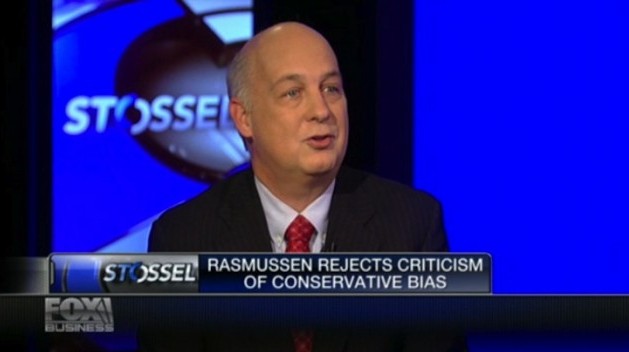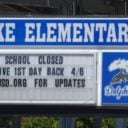

I have been debating whether or not to write this column for quite some time, but now the time has come to take Rasmussen Reports bias to task. Because Scott Rasmussen has parted ways with the public opinion enterprise he founded in 2003 over “disagreements” in business strategy, I find it to be a more agreeable and viable time to do so.
Many liberal pundits have accused Rasmussen Reports of polling bias, labeling them an inaccurate and conservative-driven polling company. The rhetoric and charges sound something akin to what you hear from conservatives regarding Public Polling Policy, otherwise known as the liberal pollster PPP. The truth, as usual, is something less cut and dry with Rasmussen Reports compared to PPP, though both firms have terrible track records.
In our model used to assess grades on the PPD Pollster Scorecard at PeoplesPunditDaily.com, we employ a similar strategy seen over at FiveThirtyEight.com for their pollster ratings. However, one major difference in analysis between our models is that they factor all polls issued by firms in the final three weeks of the campaign, while PPD examines a much longer period of time. The reason for this is simple: We want to know if a pollster is attempting to influence the narrative of the race early on, or creating an “air of inevitability” for one particular party’s candidate.
We examine past accuracy to assign the polling firm a rating from 1 to 4, which is then used to weigh the amount of influence the firm has on averages and statistically weaken the ability of one outlier poll to dramatically mislead us on the status of a race. A rating of 4, which is held by both Rasmussen Reports and Public Polling Policy (PPP), is the worst rating we assign to a polling firm.
(UPDATE: PPD now assigns actual letter grades after numerous requests to simplify for readers.)
Unlike PPP, who blatantly poll with the intention of creating a liberal agenda or an “air of inevitability” on targeted races, recent inaccuracy by Rasmussen Reports may be due to something different, altogether. Let’s look at a few different inaccuracies during different periods to 1) validate my claim they are in fact inaccurate, and 2) better articulate my point.
In 2004, much to their credit, Rasmussen Reports released some of the most accurate polls around. But in 2010, though they predicted huge Republican gains in the face of massive denial by other well-known pundits, their actual margins were way off on many individual races. When we examine final polling results without prejudice from individual races in 2010 it appears Rasmussen Reports leaned toward Republican candidates, with just 12 out of 105 surveys overestimating the margin for the Democratic candidate by 3 or more points.
That wouldn’t seem that terrible, if not for the 55 polls that overestimated Republican support by 3 or more points during the same election cycle. Overall, Rasmussen Reports missed the margin by just under 6 points on average throughout the midterm election cycle. That’s not an impressive record, at all. But it’s also not a reason to ignore their results, either.
However, in 2012 the overstating of Republican support remained and bias in Rasmussen Reports’ polls was much closer depending on the state, ending up somewhere in the neighborhood of Romney +3. Now, incredibly and surprisingly, the polling bias has swung far to the left–real far.
In the 2013 Virginia gubernatorial contest, Rasmussen Reports wasn’t even on the same planet, with their October 20 survey of 1000 likely voters showing Democrat Terry McAuliffe leading Ken Cuccinelli by a ridiculous 17-point margin. After receiving heavy criticism, even by those who conceded McAuliffe was likely leading by a modest margin, they released another poll eight days later showing a 7-point lead for the Democrat. McAuliffe barely held on to win that race by 2.5 points, underscoring the massive 10-point plus Rasmussen Reports bias toward the liberal candidate.
They performed better in their home state of New Jersey, understating Chris Christie’s support by just 2.3 points, and overstating Booker’s support by just 2 points. However, their presidential approval tracking poll has been indefensible.
Recently, Rasmussen Reports bias consistently favors and overestimates Obama’s support relative to other polling firms, particularly firms such as YouGov (frequently commissioned by The Economist) who have terrific track records of polling accuracy. Presidential tracking surveys conducted from Feb. 10 to Feb. 14 underscore the severity of the Rasmussen Reports bias. Let’s look at the table below and make some observations.
| Pub. Date | Approval Index | Strongly Approve | Strongly Disapprove | Total Approve | Total Disapprove |
|---|---|---|---|---|---|
| 14-Feb-14 | -15 | 24% | 39% | 49% | 50% |
| 13-Feb-14 | -20 | 23% | 43% | 44% | 55% |
| 12-Feb-14 | -22 | 21% | 43% | 44% | 55% |
| 11-Feb-14 | -20 | 21% | 41% | 44% | 54% |
| 10-Feb-14 | -14 | 23% | 37% | 48% | 51% |
For tracking results from Feb. 10 to Feb. 14, President Obama’s overall presidential job approval rating according to Rasmussen Reports was 48 percent approval and 51 percent disapproval, or a spread of disapprove +3. This simply doesn’t jive with the average published finding dates, which are the dates shown above.
If the Feb. 10 to Feb. 12 average found a 44 percent to 55 percent disapproval spread of 11, which was just published on Feb. 13, it is statistically impossible for the Feb. 11 to Feb. 13 period to show a 49 percent approval rating to 50 who disapprove. Aside from the fact that Rasmussen’s tracking results have a 10.5 percent average disparity with comparable polling from Gallup and Fox News, the Feb. 13 release was a wild, wild swing from the previous day’s results.
We are literally talking about a 10-point swing over the course of one day in a model that supposedly averages findings over the tracking period of several days. Comparatively, Gallup rarely ever exceeds a swing of 3 points in a single day. Because tracking polls are conducted by averaging the results over a particular period of time, such as 3 or 5 days, significant swings are suspect.
Further, historically speaking, voter intensity drives the rare instances of drastic swings, but the reverse is true with Rasmussen. Though the voter intensity is clearly on the side of disapproval, there has never been one single day when we observed a 10-point swing against the president’s job approval as was the case in approval from Feb. 10 to Feb. 14.
So, what may be behind the clear shift in Rasmussen Reports bias toward the left?
Mike Boniello, the company’s CEO, took over for Scott Rasmussen until a permanent replacement is found following the 2012 election. Boniello and other company officials claim they still use the same polling methodologies they have employed for over a decade, but that clearly is not the case.
What we do know is that Scott Rasmussen left after they performed terribly during the 2012 election cycle, and that he claimed they had “disagreements” over strategy. Whether or not those “disagreements” had anything to do with the possible adoption of new polling methodologies that are more favorable to liberal candidates, we will never know for sure. But the data certainly suggest they did just that.








Ldedwards / November 14, 2014
I’ve never seen polling so biased. One thinks there’s some threat hovering over Rasmussen. When averaged with other polling institutes, Rasmussen’s unrealistically elevated numbers, in favor of the Communist in the White House, skew the results, to the point of consistently keeping the Idiot-in- Chief’s approval ratings above 40%. This, I believe, is horse shirt.
/
mickfury / November 15, 2014
Do you know what methodology Rassmussen uses? I suspect they’re polling something like 49% Democrats/23% Independents/28% Republicans but I haven’t been able to find anything online.
/
Ldedwards / November 15, 2014
I know the polling numbers changed when Scott Rasmussen left the organization. I see very little written of the polling discrepancies since his departure. Mostly, just folks like ourselves going, “eh”?.
/
mickfury / November 16, 2014
I guess reporting on suspect polling it’s too much to ask the MSM when they clearly want to get Obama’s back.
/
Richard D. Baris (Author) / November 16, 2014
We’re trying to force some hands.
/
Richard Baris / November 15, 2014
Rasmussen claims most national surveys have a 37/31/22 D/R/I split. But, we’ve compared similar results by other pollsters with roughly the same split, and cannot account for the bias.
/
mickfury / November 16, 2014
Assuming that split is correct and that Republican approval is low, that would mean Obama has to retain nearly 100% of polled Democrats and 50% of Independents to mesh with their results. Week in, week out, with little variation? It seems quite silly from a statistical point of view.
/
Richard Baris / November 15, 2014
You are absolutely correct. Without Rasmussen Reports, Obama’s job approval rating (PPD average) has been in the upper 30s for several weeks.
http://www.peoplespunditdaily.com/2014/11/07/polls/post-election-pollster-spin-rasmussen-reports-tries-to-defend-the-indefensible/
/
Ldedwards / November 15, 2014
Absolutely, and that’s assuming a couple of the others aren’t skewed. Like mickfury said “it’s hard to believe it’s nearly 50/50”. And it is. I think there are so many threats swirling out there.
/
mickfury / November 15, 2014
Does anyone really believe that the nation is nearly 50/50 on Obama’s approval? In particular after the midterms?
For that to be true, AP, Reuters, YouGov, etc would all have to be continuously wrong and I just don’t believe that based on how credible the mainstream pollers are and how suspect Rassmussen is.
Perhaps Rassmussen would be more credible when news outlets and RCP cease to use their “findings”.
/
WhatsApp Messenger / June 13, 2016
I do enjoy the way you have presented WhatsApp issue plus it does give me personally a lot of fodder for consideration. On the other hand, through everything that I have seen, I only trust when the actual remarks pile on that people today keep on issue and not start upon a soap box regarding the news WhatsApp. All the same, thank you for this|WhatsApp superb point and even though I do not necessarily concur with it in totality, I regard your perspective.
/